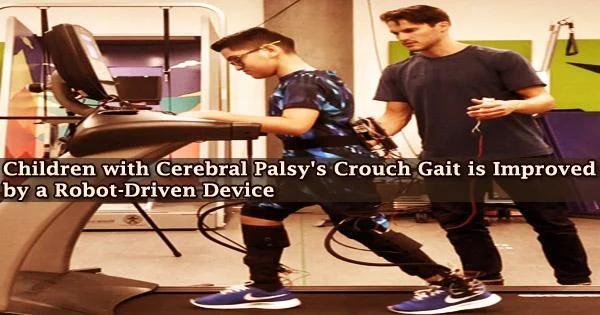3.6 out of 1000 school-age children in the U.S. have cerebral palsy (CP), according to statistics. They have aberrant walking patterns, which over time cause joint deterioration. Children with CP also struggle with slow walking speed, decreased joint range of motion, short steps, major body sways, and the absence of a heel strike.
A portion of these kids walk with a crouch gait, which is characterized by excessive hip, knee, or ankle flexion.
A pilot study demonstrating a robotic training method that improves posture and walking in kids with crouch gait by increasing their muscle strength and coordination was just published in Science Robotics by a team led by Sunil Agrawal, professor of mechanical engineering and rehabilitation and regenerative medicine at Columbia Engineering.
The combination of tight flexor muscles that reduce joint range of motion and weak extensor muscles that do not create enough muscular forces to maintain posture upright results in crouch gait.
One of the extensor muscles, the soleus, which extends from just below the knee to the heel, is crucial in preventing knee collapse when the foot is on the ground in the midst of the stance phase.
The soleus muscle, which is essential for standing and walking, maintains the shank upright throughout the mid-stance phase of the stride to enable knee extension. Additionally, it gives the body propulsive forces during the late stance phase of the gait cycle.
“One of the major reasons for crouch gait is weakness in soleus muscles,” says Agrawal, who is also a member of the Data Science Institute.
“We hypothesized that walking with a downward pelvic pull would strengthen extensor muscles, especially the soleus, against the applied downward pull and would improve muscle coordination during walking. We took an approach opposite to conventional therapy with these children: instead of partial body weight suspension during treadmill walking, we trained participants to walk with a force augmentation.”
Feedback from the parents and children involved in this study was consistent. They reported improved posture, stronger legs, and faster walking speed, and our measurements bear that out. We think that our robotic TPAD training with downward pelvic pull could be a very promising intervention for these children.
Heakyung Kim, A. David Gurewitsch
The research team was aware that when more weight is added to the human body during gait, the soleus the main muscle responsible for supporting the body’s weight during single stance is recruited more powerfully among the lower leg muscles. They reasoned that soleus muscle strengthening might make it easier for kids with crouch gait to stand and walk.
The scientists employed a robotic device called Tethered Pelvic Assist Device (TPAD), developed in Agrawal’s Robotics and Rehabilitation (ROAR) Laboratory, to test their theory. A wearable, lightweight cable-driven robot called the TPAD can be programmed to apply forces on the pelvis while a subject is walking on a treadmill in a particular direction.
The study’s six-week duration involved fifteen 16-minute training sessions with six CP-affected kids who exhibited crouch gait. The TPAD was worn by the kids as a thin pelvic belt with multiple wires attached while they walked on treadmills.
Based on real-time motion capture data from cameras, a motor mounted on a stationary frame around the treadmill was used to adjust the tension in each TPAD wire. To specifically retrain the activity of the soleus muscles, the researchers configured the TPAD to apply an additional downward push through the region of the pelvis.
Based on the results of healthy children carrying backpacks, they applied a downward force equal to 10% of body weight. This was the lowest weight at which walking posture or gait would noticeably change.
“TPAD is a unique device because it applies external forces on the human body during walking,” says Jiyeon Kang, PhD candidate and lead author of the paper. “The training with this device is distinctive because it does not add mass/inertia to the human body during walking.”
Using electromyography data from the first and final training sessions as well as ongoing monitoring of kinematics and ground response forces, the researchers evaluated the kids’ muscular power and coordination.
They discovered that their instruction was successful because it boosted the kids’ good posture and enhanced their muscle coordination. Additionally, their gait characteristics, such as step length, lower limb range of motion angles, toe clearance, and heel-to-toe pattern, all improved.
“Currently, there is no well-established physical therapy or strengthening exercise for the treatment of crouch gait,” Agrawal notes.
Heakyung Kim, A. David Gurewitsch Professor of Rehabilitation and Regenerative Medicine and Professor of Pediatrics at the Columbia University Medical Center, who treats these patients, added “Feedback from the parents and children involved in this study was consistent. They reported improved posture, stronger legs, and faster walking speed, and our measurements bear that out. We think that our robotic TPAD training with downward pelvic pull could be a very promising intervention for these children.”
More clinical trials are being planned by the researchers in order to evaluate a larger sample and experiment with more variables. They are also considering studying children with hemiplegic/quadriplegic CP.





